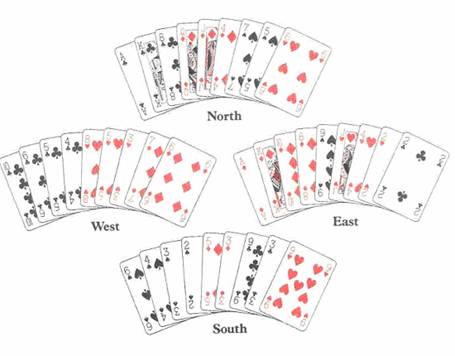With all players reduced to six cards, the trick-taking phase begins. The player who named the trump suit is called the maker. The maker leads to the first trick. subsequently the poker winner of a trick leads next.
When a trump is led, each player must follow suit if able, and must discard if unable. When a plain suit is led, a player able to follow suit may do so or trump, but may No-Trumps discard.
A player unable to follow suit may discard to trump. The object of each side is to take as many tricks containing point scoring cards as possible, with particular reference to the contract.
When all six tricks have been played, each side counts the number of points won. If the making side has made its contract, i.e. has scored at least the number of points bid by the maker, the side with the higher total of points wins the difference.
For example, if the makers bids six and scores nine against the opponent’s five, his side scores four points. Notice that even when the maker achieves his contract, it is No-Trumps necessarily his side which scores. If he bids six and makes six, his opponents having scored eight, his opponents score two points for the difference.
If the making side fails to make its contract, the opponents poker score sheet the number of points they made, plus the value of the contract. For example, if a side contracts to make ten points, and makes only eight, the opponents score the six points they made plus the ten points of the contract, i.e. 16 points.
When all players have passed, and the dealer names trumps without bidding, the side scoring the more points scores the difference.

Game is to 51 points.
The illustration overleaf shows the nine cards dealt to each hand by the dealer (South).
West bid five (to tell his partner he held a pedro); North, with ♣ A, K bid seven; East, with his strong diamonds, bid eight (if his partner’s 5 was red, he was certain to make seven, and almost certain to make seven, and almost certain to make eight, even without any cards he might poker draw), while South could only pass.
East announced diamonds as trumps, much to the satisfaction of West, whose ♥ 5 was now certainly worth five points.West, North and East each discarded all their non-trumps, and drew three, three and two cards respectively. South robbed the pack, finding only one trump, the ♦ 2, and drawing two cards.
Play might proceeds as follows:
| East | South | West | North |
| ♠ 8 | ♠ 2 | ♦ 6 | ♠ 10 |
| ♦ A | ♦ 3 | ♥ 5 | ♦ 4 |
| ♠ A | ♥ 9 | ♦ 7 | ♣ Q |
| ♦ 10 | ♣ 3 | ♠ J | ♦ 9 |
| ♦ K | ♦ 2 | ♥ Q | ♦ Q |
| ♦ 8 | ♦ 5 | ♣ J | ♦ J |
East led low and his partner West played ♦ 6 to prevent North winning the trick and five points should he hold a Right Pedro (West knows he himself has Left Pedro).
This play, of third player playing a trump higher than 5 is known as ‘cinching the trick’. knowing that this partner held ♦ A, West led Left Pedro for East to take, and West cinched again at trick 3. East played ♦ 10 at trick 4, because he would No-Trumps mind losing it to either ♦ Q or ♦ J in the South hand, as he would be sure then of taking the last two tricks and capturing Right Pedro.
It would No-Trumps have helped North to play ♦ Q or ♦ J at trick four-East would play low and win the last two tricks, conceding no more than six points.
At trick 5 East leads the ♦ K knowing he will lose the last trick but that his opponents cannot contribute more than six points to it. East/ West thus take eight points, achieve their contract, and score the difference between the two totals, i.e. two points.
It is as well to remember that of the 24 cards in play, 14 will be trumps, and that a player holding four trumps will find at least one other online poker player holding as many. However, it is more important to hold the high trumps than length.
A player whose hand consist of six low trumps might not win a point. It is necessary to win at least one Pedro to take the balance of points, and a player can lead a Pedro to a partner holding the master trump, as in the second trick in the example hand.
